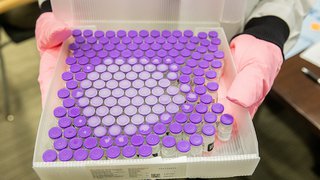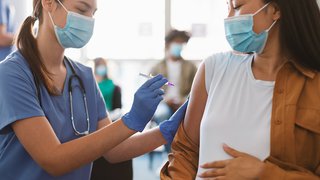
Face coverings have become a flashpoint in the U.S., particularly now as COVID-19 cases continue to surge in Texas, Florida, and Arizona, among other states.
Misinformation and mixed signals about masking have spread almost as quickly as the virus. And political debates pitting civil liberties vs. civic responsibilities have drowned out the growing body of evidence that shows wearing masks significantly reduce infection risk.
As a specialist in lung disorders and pulmonary disease, I treat respiratory infections every day and have seen firsthand the aggressive nature in which they can spread. Wearing a mask to protect yourself and others against COVID-19 pandemic seems like a no-brainer. But I can understand how “caution fatigue” and conflicting messages might cloud our judgment.
So, let’s take a look at some of the most common myths surrounding masks and separate them from the medical and scientific realities of our situation.
Myth:
Masks don’t really provide protection from COVID-19.
Reality:
Wearing masks can reduce the risk of spreading COVID-19 to about 3%.
That's according to a review of 172 studies worldwide that was recently published in The Lancet. In the U.S., data have shown that states requiring masks in public since April have avoided anywhere from 230,000 to 450,000 new COVID-19 cases. In New York, 66,000 cases were averted between April 17 and May 9.
The novel coronavirus is spread through respiratory droplets released when we cough, sneeze, talk, sing, or yell. Covering your nose and mouth, whether it’s with a surgical mask or homemade cloth mask, is an effective way of containing those droplets and protecting others.
Myth:
Only people who are infected or have weak immune systems need masks.
Reality:
Asymptomatic people account for 40% to 45% of COVID-19 infections.
Recent studies have shown that those individuals can transmit the virus for more than 14 days without knowing it. The notion that masks are only for people who are sick, elderly, or have preexisting conditions simply isn’t true. In fact, new cases in Dallas County in the 21-40 age group have increased dramatically in recent weeks, while the case count in other age groups has remained stable, according to UT Southwestern’s forecasting model. And nearly half of all hospitalizations in Dallas-Fort Worth are patients younger than 50.
COVID-19 on the rise: ‘We’ve let our guard down’
6.19.20
As cities in Texas and across the country have reopened, COVID-19 cases have steadily increased. Dallas COVID-19 Czar Dr. Kelvin Baggett and UT Southwestern infectious diseases expert Dr. Richard Medford discuss the troubling trend, reveal what we can do to help reverse it, and advise when to get tested.
Myth:
Wearing a mask can make people sick from carbon dioxide poisoning.
Reality:
Health care workers have worn masks for years with no ill effects.
Cloth face coverings and masks don’t trap enough carbon dioxide to be harmful, and because most people won’t be wearing a mask for hours or days, the risk of carbon dioxide poisoning, or hypercapnia, is nearly nonexistent. Similarly, any suggestion that masks deprive people of oxygen is unfounded. Masks are very safe when worn properly.
Myth:
Wearing a mask protects other people but not me.
Reality:
Masks help everyone keep their droplets to themselves, which significantly reduces the spread of respiratory infections.
A recent study in the New England Journal of Medicine and an accompanying video illustrate just how effective any form of face covering can be at catching droplets that are released when talking, which is the primary form of COVID-19 transmission. Masks are also an indirect reminder not to touch your face, which is another way they can protect the wearer.
More COVID-19 coverage from UT Southwestern
Myth:
If a mask covers my mouth, I’m good.
Reality:
Respiratory droplets are released from your nose and mouth.
It’s essential that a mask fits snugly over the bridge of your nose and chin to create the best possible seal. Leaving your nose uncovered makes you vulnerable to inhaling or expelling viral particles when you breathe, cough, and sneeze, as well as risking contamination from the exterior of your mask.
Myth:
If everyone wears a mask, we don’t need to social distance.
Reality:
Wearing a mask is one of several nonpharmaceutical interventions recommended by infectious disease experts to combat the pandemic.

Other important NPIs are physical distancing (staying at least six feet away from others in public settings), avoiding large gatherings, and frequent hand-washing. One safety precaution does not eliminate the need for the others.
For example, most masks are not airtight, so the combination of physical distance and a face covering gives you more protection from the virus. You can also still get COVID-19 from touching a surface and then touching your face, so hand hygiene remains vital. If you’re going to attend an outdoor gathering, wear a mask, maintain your distance, and keep your hands sanitized.
Related reading: telehealth optionsSick of social distancing, trying these NPIs on for size
Myth:
N95s are the only masks that provide protection against COVID-19.
Reality:
Nearly all face coverings can block respiratory droplets, lab tests show.

An N95 mask is able to block 95% of small and large airborne particles, which is why it’s considered a critical item for frontline health care workers and first responders. But even N95s can be ineffective if not properly fitted. (At UT Southwestern, we get ours fit tested).
Surgical and cloth masks can be very effective at blocking large particles such as respiratory droplets, according to laboratory tests. Homemade face coverings are also effective, particularly if they include multiple layers of fabric and fit snugly against your face. Please visit our webpage for more details on how to make and wear a mask.
Myth:
Businesses can’t make me wear a facemask.
Reality:
Dallas and Tarrant counties recently made masks mandatory.
Dallas County Commissioners approved an order that went into effect June 20 that requires businesses to ensure customers and employees wear a face covering while inside and six feet of physical distance isn’t possible. The order, which makes exceptions for eating, extends through at least Aug. 4. Tarrant County has followed suit with a masking order beginning June 26.
Businesses that don’t comply face a $500 fine per violation in Dallas. Fines in Tarrant County are $1,000 per violation.
Other large counties in Texas have enacted similar policies. Some businesses, such as airlines, had already begun requiring customers to wear masks and, in some cases, have denied service to those who refuse.
A handful of states, including California and New York, have also issued statewide orders requiring people wear masks in public spaces.
Myth:
All masks have to be thrown out after one use.
Reality:
Cloth masks are reusable and should be washed after each use.
The Centers for Disease Control and Prevention (CDC) recommends routinely washing cloth face coverings after each wearing. They are safe to put in the washing machine and dryer with other clothes. The process should effectively kill any virus that might remain on the mask.
Surgical masks and N95s are designed to be disposable, but in light of possible shortages, disinfection protocols have been developed for both, according to a recent study in the Journal of the International Society for Respiratory Protection.
Myth:
Even if the entire country wore a mask it wouldn’t make a difference.
Reality:
Universal masking has dramatically reduced infection rates in several countries.
Mortality rates from COVID-19 have increased rapidly each week since May 9 in countries that have not mandated mask usage, according to a recent analysis of cases in 194 countries. A Texas A&M study concluded that wearing a face mask in public is the most effective way to prevent human-to-human transmission. And a modeling study in Proceedings of the Royal Society, asserted that if the majority of people wore face masks in public — any kind of mask worn properly — transmission of COVID-19 would be reduced dramatically and it could prevent future waves of the pandemic.

The value of wearing a mask is no myth
The public has received mixed signals on the need for masks since early March, when the CDC initially advised against everyone wearing one. But as more evidence became available, particularly related to asymptomatic spreaders, the public health agency reversed course in early April. The World Health Organization (WHO) revised its guidelines June 5.
By that point, most states had begun relaxing restrictions and reopening businesses. Memorial Day and the start of summer led to larger gatherings and a false sense the virus was behind us. It’s not, as the last few weeks of record-setting numbers have made painfully clear.
There is hope for the future. Vaccines are being rapidly developed and tested, and clinical trials for treatments are ongoing, but at the moment COVID-19 is still highly infectious and active in our communities. Now is the time to be vigilant about taking precautions, especially with July Fourth coming up and summer travel in full swing. That means social distancing, washing hands frequently, and most importantly wearing a mask to protect yourself and your loved ones.
Are face coverings a cure-all for COVID-19? Nothing is at the moment. But I can tell you that right now wearing a mask when you’re in close proximity to other people is 100% better than not wearing one.














